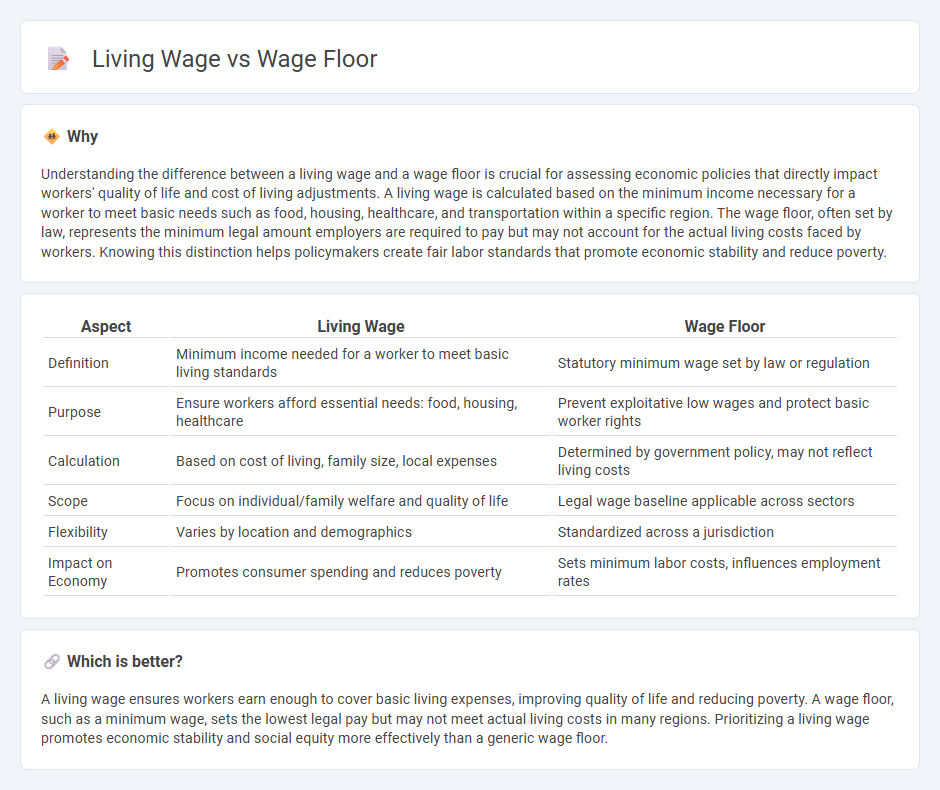
A living wage ensures workers earn enough to cover basic living expenses, reflecting local cost of living variations, whereas a wage floor sets the minimum legal salary, often lower than actual living costs. Economies applying living wage standards aim to reduce poverty and improve quality of life, contrasting with minimum wage policies that primarily protect against exploitative pay. Discover more about how these wage policies impact economic stability and social equity.
Why it is important
Understanding the difference between a living wage and a wage floor is crucial for assessing economic policies that directly impact workers' quality of life and cost of living adjustments. A living wage is calculated based on the minimum income necessary for a worker to meet basic needs such as food, housing, healthcare, and transportation within a specific region. The wage floor, often set by law, represents the minimum legal amount employers are required to pay but may not account for the actual living costs faced by workers. Knowing this distinction helps policymakers create fair labor standards that promote economic stability and reduce poverty.
Comparison Table
| Aspect | Living Wage | Wage Floor |
|---|---|---|
| Definition | Minimum income needed for a worker to meet basic living standards | Statutory minimum wage set by law or regulation |
| Purpose | Ensure workers afford essential needs: food, housing, healthcare | Prevent exploitative low wages and protect basic worker rights |
| Calculation | Based on cost of living, family size, local expenses | Determined by government policy, may not reflect living costs |
| Scope | Focus on individual/family welfare and quality of life | Legal wage baseline applicable across sectors |
| Flexibility | Varies by location and demographics | Standardized across a jurisdiction |
| Impact on Economy | Promotes consumer spending and reduces poverty | Sets minimum labor costs, influences employment rates |
Which is better?
A living wage ensures workers earn enough to cover basic living expenses, improving quality of life and reducing poverty. A wage floor, such as a minimum wage, sets the lowest legal pay but may not meet actual living costs in many regions. Prioritizing a living wage promotes economic stability and social equity more effectively than a generic wage floor.
Connection
A living wage sets the minimum income necessary for workers to meet basic living standards, directly influencing the establishment of a wage floor, which acts as the legally mandated minimum pay employers must provide. Implementing a wage floor based on living wage calculations helps reduce poverty and income inequality by ensuring wages align with actual cost-of-living metrics. Economic policies integrating living wage data into wage floor determinations promote fair compensation and stimulate consumer spending, boosting overall economic growth.
Key Terms
Minimum Wage
The minimum wage is a legally mandated wage floor designed to protect workers from exploitative pay, ensuring a baseline income across various industries and regions. Unlike the living wage, which calculates the income needed to maintain a decent standard of living based on local costs for essentials like housing, food, and healthcare, the minimum wage often falls short of meeting these comprehensive needs. Explore detailed comparisons and impacts on labor markets by learning more about wage policies and their social effects.
Cost of Living
The wage floor, often defined as the statutory minimum wage, sets the legal baseline employers must pay workers, whereas a living wage is calculated based on the actual cost of living in a specific region, ensuring workers can meet basic needs like housing, food, and healthcare. Living wages tend to exceed wage floors, reflecting real-world expenses and socio-economic factors to promote financial stability and reduce poverty. Explore more to understand how these wages impact economic equity and workforce sustainability.
Purchasing Power
Wage floor policies set the minimum legal pay to prevent exploitation, often falling short of covering basic living expenses, while living wage standards aim to align earnings with the actual purchasing power needed for essential goods and services within a local economy. The disparity between wage floors and living wages highlights the economic challenges faced by low-income workers, especially in high-cost urban areas where inflation erodes real income. Explore detailed analyses on how purchasing power influences wage policies and socioeconomic well-being.
Source and External Links
Wage Floor Law and Legal Definition | USLegal, Inc. - A wage floor is the minimum wage established by law or agreement below which wages are not allowed to fall, serving as the lowest legally permitted wage in an industry or organization.
Raises from Coast to Coast in 2025 - By 2025, numerous U.S. states and localities will raise their minimum wage floors, with many reaching or exceeding $15.00 or even $17.00 per hour for some or all employers.
Walk the Talk: Is it Time to Consider a Living Wage Floor? - A living wage floor is a wage threshold set to ensure employees earn enough for a basic standard of living, often higher than legal minimum wages, and aligned with an organization's equity values.
 dowidth.com
dowidth.com